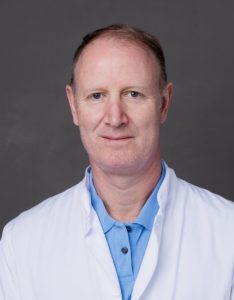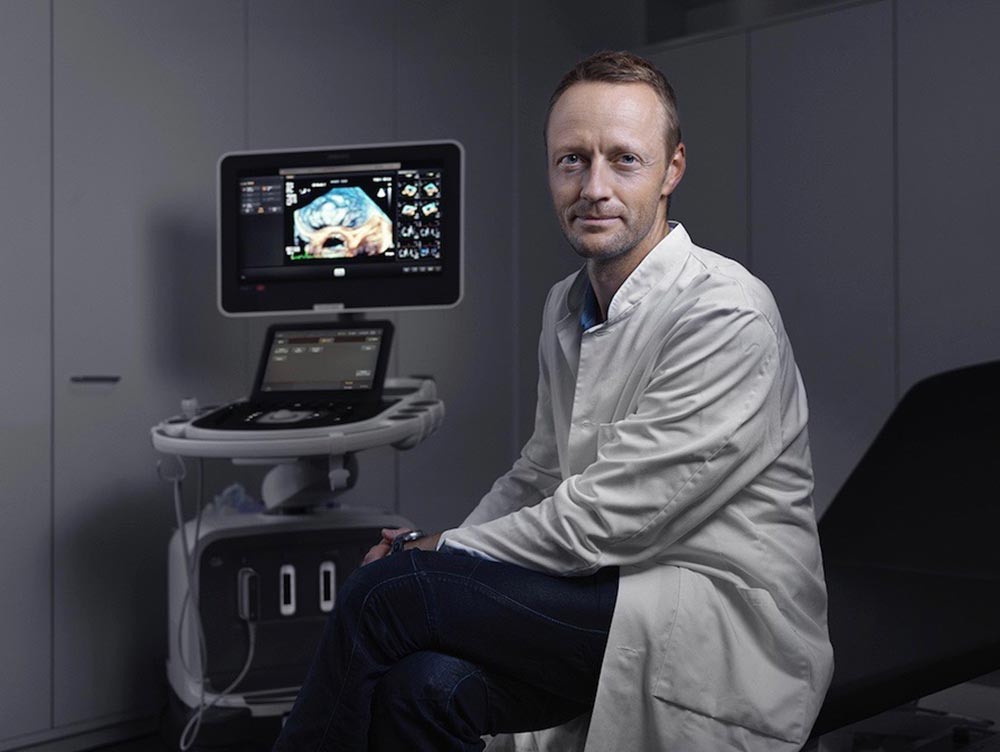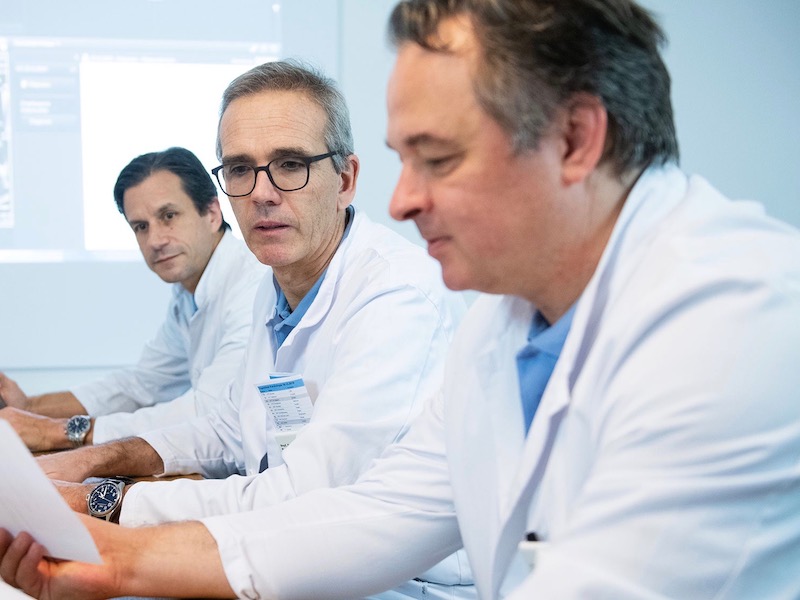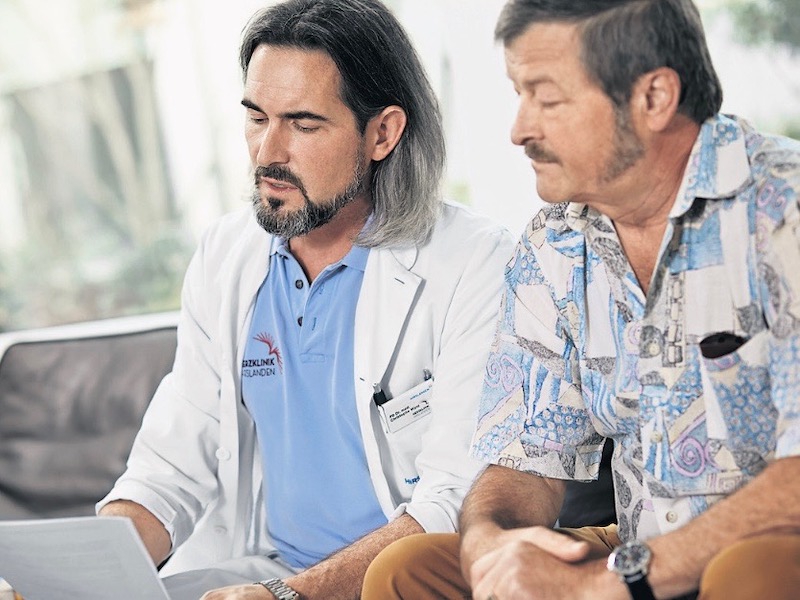Minimally invasive heart surgery
08 January 2019
Prof. Dr. Jürg Grünenfelder, specialist in cardiac and thoracic vascular surgery at Herzklinik Hirslanden, is a specialist in minimally invasive mitral valve reconstruction. Using this gentle surgical method, patients benefit from optimal results and regain their fitness more quickly.
Interview with Prof. Dr. med. Jürg Grünenfelder

Prof. Dr. med. Jürg Grünenfelder - Specialist Cardiac and Thoracic Vascular Surgery - HerzKlinik Hirslanden
What is mitral valve repair?
Prof. Dr. Jürg Grünenfelder: The mitral valve is one of the four heart valves and is located between the left atrium and the left ventricle. With every contraction of the heart, it prevents the backflow of blood into the atrium. The valve leaflets are attached directly to the heart muscle by tendon threads so that they close tightly with every contraction. If these threads are defective or the leaflets are perforated or overstretched, the valve can no longer fully perform its sealing function. In mitral valve repair, these defects are repaired so that the heart can once again perform at its full capacity.
How does valvular heart disease develop?
Prof. Dr. Jürg Grünenfelder: Valve defects are partly congenital, but can also develop in the course of life due to genetic predisposition or a weakness of the connective tissue. Unfortunately, no preventive measures can be taken because there are no known risk factors. Accordingly, mitral valve insufficiency is not rare; it is one of the most common valve diseases.
How is valvular heart disease detected?
Prof. Dr. Jürg Grünenfelder: Mitral valve regurgitation often goes undetected. The diagnosis is usually made when an unusual heart murmur is detected during the annual check-up with the family doctor. If the disease remains untreated over a long period of time, it can become noticeable through reduced performance, impaired heart function, atrial fibrillation or an enlarged heart. People aged 60 and over are usually affected.
In which patients is mitral valve surgery recommended?
Prof. Dr. Jürg Grünenfelder: Heart surgery always has a certain risk. Therefore, it should be weighed up whether an operation is really necessary. Mild and moderately severe cases are not usually treated, as surgery only brings a relatively small improvement in quality of life. Only in severe cases is surgery recommended. However, it has also been shown that early treatment is particularly useful in mitral valve surgery. If the patient has already developed severe symptoms as described above, the results after surgery are less satisfactory than if surgery is performed immediately. In principle, any patient with mitral valve regurgitation is suitable for surgery. In general, however, it can be said that especially our younger, fit patients of about 50 to 70 years of age benefit from surgery - in them a great improvement in quality of life as well as prolongation of life can be expected.
What are the details of mitral valve surgery?
Prof. Dr. Jürg Grünenfelder: Normally, for mitral valve surgery, a so-called sternotomy is performed. This means that the sternum is opened and thus the heart is exposed. This results in a relatively large wound of about 15 to 20 centimeters in length. In the minimally invasive operation, a much smaller, lateral incision of about five to six centimeters is made above the ribs, which are then spread, making the heart accessible to the instruments. In both versions, the heart-lung machine is used - in the open procedure directly via the opening at the sternum, in the minimally invasive procedure via the inguinal vessels. There is also no difference in the duration of the operation.
What are the advantages of minimally invasive mitral valve surgery?
Prof. Dr. Jürg Grünenfelder: There are a few: The smaller wound is a much gentler procedure. It leads to less blood loss, a lower risk of secondary infections and kidney failure, so that on average the patient can leave the hospital sooner. In addition, with this lateral approach, the direct view of the mitral valve is better, making the complex surgery somewhat easier. This allows the valve to be reconstructed in most cases rather than having to be replaced by a prosthesis. This represents a foreign body and can become non-functional again after a certain time.
How established is the minimally invasive surgical technique in Switzerland?
Prof. Dr. Jürg Grünenfelder: Herzklinik Hirslanden is one of only a few hospitals in Switzerland where mitral valve regurgitation surgery can be performed routinely using a minimally invasive procedure. Internationally, this method is already becoming the standard instead of chest opening, among other things because of the numerous advantages for the patient described above: the same result is achieved with a smaller wound.
More reports
Cardiac Imaging (Heart Imaging)
Techniques of imaging the heart (cardiac imaging): Imaging the heart (cardiac imaging) is indispensable for making a diagnosis....
HerzTeam: Experience is decisive
The experience of the heart team is crucial Stenosis and leakage of the heart valve are among the most common structural heart diseases. The...
Heart attack - Precious minutes
Every minute is precious in a heart attack The earlier a heart attack is treated, the higher the chance of survival and the...
Successful reconstruction of the tricuspid valve
Ernst Spalinger has confidence in his heart again. After the operation on the tricuspid valve, fear and shortness of breath are blown away....
Structural heart disease
What is structural heart disease? Structural heart disease refers to diseases of the heart that predominantly affect one of the four heart valves,...
Gentle heart surgery with the DaVinci robot
Interview with Prof. Dr. med. Jürg Grünenfelder The DaVinci surgical robot is mainly known from the field of prostate surgery. In the...
All specialists at the Heart Valve Center of Herzklinik Hirslanden
Prof. Dr. med. ROBERTO CORTI
Interventional Cardiology
Prof. Dr. med. JÜRG GRÜNENFELDER
Cardiac Surgery
MD. THIERRY AYMARD
Cardiac Surgery
PD Dr. med. PATRIC BIAGGI
Cardiology | Imaging
Prof. Dr. med. OLIVER GÄMPERLI
Interventional Cardiology
PD Dr. med. DAVID HÜRLIMANN
Cardiology | Rhythmology
Dr. med. IOANNIS KAPOS
Cardiology | Imaging
MD. SILKE WÖRNER
Cardiology | Imaging
Prof. Dr. med. GEORG NOLL
Cardiology | Prevention
MD. IVANO REHO
Cardiology | Aortic Aneurysm
PD Dr. med. (H) DIANA RESER
Cardiac Surgery
Prof. Dr. med. JAN STEFFEL
Cardiology | Rhythmology
Prof. Dr. med. PETER M. WENAWESER
Interventional Cardiology
Prof. Dr. med. CHRISTOPHE WYSS
Interventional Cardiology





